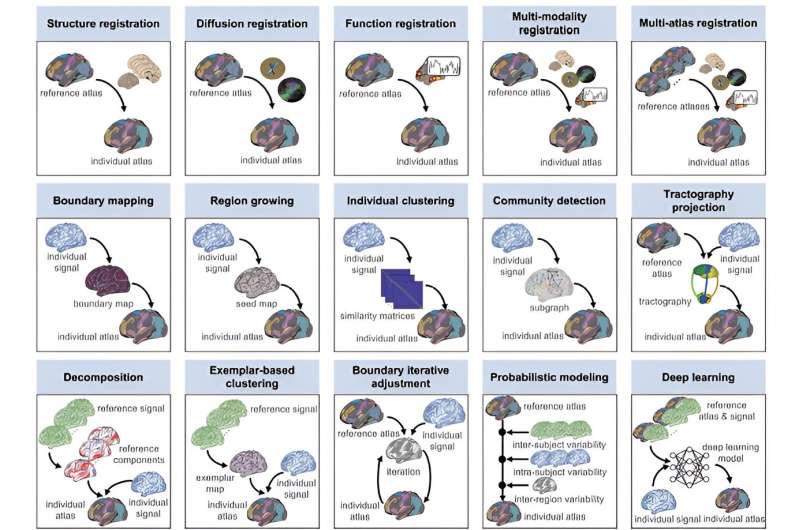This article has been reviewed according to Science X's editorial process and policies. Editors have highlighted the following attributes while ensuring the content's credibility:
fact-checked
proofread
Review explores personalized brain mapping and navigated neuromodulation

Brain atlases aid in understanding the intricate human brain, supporting research on functional circuits, behaviors, and diagnostics. They come in structural and functional forms, revealing anatomy and active areas during processes.
Neuromodulation techniques like transcranial magnetic stimulation (TMS) and deep brain stimulation (DBS) target specific brain regions for personalized treatments by targeting specific brain regions and altering neural activity. However, the variability in brain structure and function challenges precision treatments, as traditional atlases lack fine-scale details and functional parcellation.
To address these limitations, individualized brain mapping methods become crucial for tailored neuromodulation strategies. They have evolved from manual labeling to staining techniques across multiple subjects. These methods aim to overcome limitations in accuracy and replicability, crucial for advancing personalized brain mapping in living subjects.
In a new article published in the Chinese Medical Journal, a team of scientists led by Professor Lingzhong Fan from the Institute of Automation, Chinese Academy of Sciences, Beijing, reviewed recent advances made in the field.
The article groups mapping methods into three broad categories: registration-based methods, unsupervised learning-based approaches, and group-prior-guided methods. It discusses methodological profiles, advantages, disadvantages, and application trends of these methods while outlining advancements in non-invasive neuromodulation and localization in DBS.
Registration-based methods align reference brain atlases with individual brains, enhancing anatomical detail. Single-modality MRI registration minimizes differences but overlooks diffusion and functional patterns. Multi-modality techniques merge data for a comprehensive view but struggle with individual differences. Multi-atlas registration offers flexibility, combining parcellation patterns from various atlases.
While single modality lacks parcellation insight and multi-modality faces variability, multi-atlas registration remains flexible for personalized brain mapping. Future trends might integrate cross-modality registration and deep learning for diverse clinical applications.
Unsupervised learning-based individualized brain mapping focuses solely on MRI data. Techniques like boundary mapping, region growing, individual clustering, and community detection segment brain tissues into distinct regions. These methods leverage MRI data for enhanced specificity, emphasizing local variability or global relationships.
Advancements aim to adapt these techniques to broader clinical use with low-resolution data, while high-resolution data will propel their use in neuroscience.
Group-prior-guided individualized brain mapping methods have emerged to address limitations in unsupervised learning-based techniques, aiming to integrate individual specificity and population commonality. Techniques like tractography projection, decomposition, exemplar-based clustering, boundary iterative adjusting, probabilistic modeling, and deep learning leverage atlases for construction.
Tractography struggles with accuracy and decomposition with negative loadings, and exemplar-based clustering demands complexity. These methods combine specificity and commonality, showing promise in research and clinical settings. Technology and data quality improvements will enhance their clinical utility.
Furthermore, individualized brain mapping is used in TMS for depression treatment.
"Although the traditional therapeutic approaches, such as medication and psychotherapy, are effective in treating depression, they do not work for approximately 20%–30% of patients diagnosed with major depression disorder. TMS was there proposed as an alternative therapeutic approach that directly affects neural activity and modulates neuroactivity in ways that differ from conventional approaches," clarify Prof. Fan and his team.
Various methods aim for disease-specific TMS targets, but challenges persist in accuracy and specificity. Integrating neuroimaging enhances precision, while advancements in deep brain TMS coils promise tailored treatments.
"DBS has been employed to address a range of neurological and psychiatric disorders. Awake DBS surgery involves electrode implantation using microelectrode recording (MER) and intraoperative test stimulation with patients in an awake state. In contrast, asleep DBS surgery is performed under general anesthesia without neurophysiological recording or stimulation," explains Prof. Fan and his team.
They differ in precision and risks. Combining imaging improves accuracy, yet variations remain. Monitoring brain activity during surgery fine-tunes targeting, but each modality has limitations. Advancements in imaging tech hold promise for refining DBS strategies, but achieving individualized targeting remains a challenge.
Transitioning to neuroimaging-based asleep DBS enhances precision and reduces surgery duration. Technological advancements improve stimulation flexibility and safety, yet group brain atlases may limit individualized treatment. Fine-grained atlases are vital for precise targets, advancing patient care and surgical accuracy. Integrating brain mapping with DBS holds potential for tailored treatments.
As we step into a future where personalized medicine is becoming a reality, individualized brain mapping techniques offer exciting promise. These tailored approaches will help us gain a better understanding not only of how the brain works but of the variations in unique characteristics from one person to another.
More information: Chaohong Gao et al, Individualized brain mapping for navigated neuromodulation, Chinese Medical Journal (2024). DOI: 10.1097/CM9.0000000000002979


















